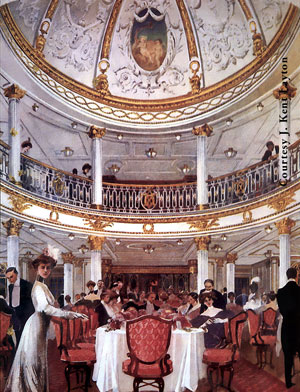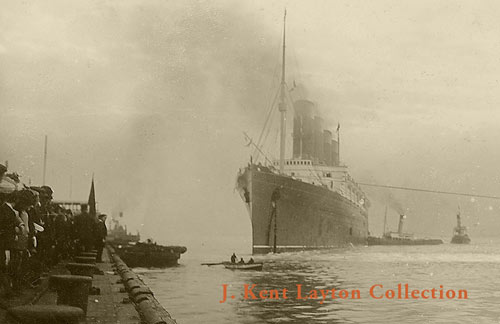Victory for the Lusitania
This is the fourth blog post in a series by J Kent Layton, maritime historian and author of ‘Lusitania: an illustrated biography’, to accompany the exhibition Lusitania: life, loss, legacy at the Maritime Museum.

The Lusitania tied up in New York at the conclusion of her maiden crossing.
On her return to New York she officially became the fastest ship in the world.
© Library of Congress, Prints and Photographs Division/ J Kent Layton Collection
Saturday 7 September 1907 was an unforgettable day in the annals of maritime history: the Lusitania was to begin her maiden voyage from Liverpool, England that evening. Excitement was running high and bookings for the crossing were strong. Britishers, alarmed at the way their maritime prestige had been usurped by German liners during the preceding decade, were keen to see their new greyhound take back the Blue Riband. Newspapermen from both sides of the Atlantic had booked passage on the crossing, eager to send daily updates back to their editors.
This illustration shows passengers enjoying the finery of the
Lusitania's first class dining saloon. © J Kent Layton Collection
The first class passenger list, which is available in full in 'Lusitania: an illustrated biography', was filled with the names of many prominent people of the day. Many prominent Cunard personnel, including EH Cunard – a member of Cunard's Board of Directors and grandson of the company's founder – were aboard; so, too, were employees of the John Brown shipyard which had built the ship. A crowd of some 200,000 spectators saw her off, cheering and singing 'Rule, Britannia' as she slipped her moorings and steamed into the night.
Disappointingly, the maiden voyage proved unremarkable. Although passengers were excited about the liner and the trip, the simple fact is that no attempt was made to make a record passage. Indeed, her arrival time in New York was pretty well fixed even before she had entered the Atlantic. This was because the new Ambrose Channel into New York Harbor was yet incomplete, and its use by the Lusitania was approved only during daylight. The maiden crossing was made at an average speed of 23.01 knots, over the course of 5 days, 54 minutes: quick, but not record breaking. The Germans retained the record by only a half-hour's time. The Lusitania's passengers were very generous in their praise of the liner. Her return to England was made at 22.58 knots—again, not a record.
The Lusitania approaches the Prince's Landing Stage in Liverpool for the first time.
© J Kent Layton Collection
However, the maiden voyage was successful in many respects, and on her second round-trip voyage the liner was pushed to show her real capabilities. By the time she had reached New York, she had made an average speed of 24.002 knots, taking the Blue Riband in the west-bound direction; returning to Europe, she took the east-bound Blue Riband by averaging 23.61 knots, despite some rough weather. On her third west-bound crossing, she upped the ante by averaging 24.25 knots over the course of the trip, in spite of a ferocious gale that was strong enough to damage some of the ship's equipment. Meanwhile, the Lusitania's slightly larger, slightly younger sister was undergoing trials, and gave indications that she might actually prove to be the faster of the two ships. The question was: how well would the ships perform in service together? The answer would not be long in coming.


